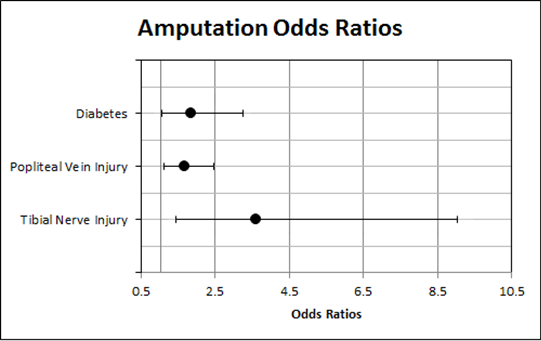Contemporary Outcomes of Blunt Popliteal Artery Injury: A Propensity-Matched Analysis of the National Trauma Data Bank
John Futchko, MD, Afshin Parsikia, MS, Amit Shah, MD, John McNelis, MD, Melvin E. Stone, Jr., MD, Evan Lipsitz, MD, Aksim Rivera, MD.
Jacobi Medical Center, New York, NY, USA.
OBJECTIVES:
Traumatic popliteal artery injury is associated with an increased propensity for limb loss, morbidity, and mortality above an already elevated baseline risk to life and limb. Previous studies on outcomes in this patient group have been limited by selection bias. Our study evaluated outcomes following blunt popliteal artery injury using propensity matching to reduce selection bias and identify factors associated with amputation.
METHODS:
We conducted a retrospective review of prospectively collected data from the National Trauma Data Bank (NTDB). Patients were identified using ICD-9 codes related to patterns of blunt injury associated with popliteal arterial injury or intervention. Using Trauma Quality Improvement Program (TQIP) models as a reference, specific demographics, injury characteristics, and interventions were collected. Variables found significant on univariate analysis were used to generate propensity-matched amputation and non-amputation cohorts. Multivariate logistic regression was used to assess for risk factors associated with amputation.
RESULTS:
In total, 3,029 patients with popliteal artery injury were identified; 628 (20.7%) underwent amputation. Patients who underwent amputation presented with hypotension (systolic blood pressure 0-99 mmHg, 22.7% vs 12.8%, p<0.001) and tachycardia (heart rate >120, 28.5% vs 14.5%, p<0.001). Limb loss was also associated with concurrent popliteal vein (18.3% vs 8.7%, p<0.001) and tibial nerve (5.3% vs 1.3%, p<0.001) injury, as well as elevated injury severity score (ISS, median 13 vs 9, p<0.001) and abbreviated injury scale (AIS, 3 vs 2, p<0.001). Subsequently, 724 patients were divided into equal number propensity-matched amputation and non-amputation cohorts. Multivariate analysis revealed that patients with Diabetes Mellitus (OR 1.895, p=0.023), popliteal vein injury, (OR 1.672, p=0.010) or tibial nerve (OR 3.602, p=0.006) injury were more likely to undergo amputation.

CONCLUSIONS:
Trauma patients who sustain blunt popliteal artery injury are at an increased risk of amputation. Propensity-matched analysis revealed that both popliteal vein and tibial nerve injury, but not severity of tissue injury, predicted limb loss.
Back to 2018 Program




